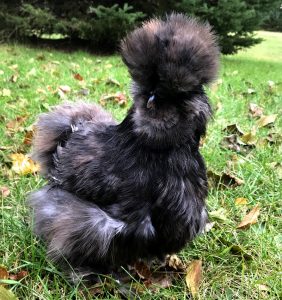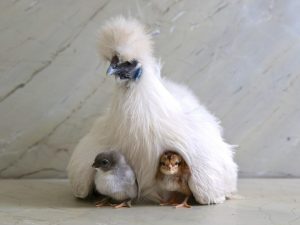Attention: Sometimes we receive a commission when you make a purchase through the links on our site.
You might hear them called teddy bears or fluff balls due to their unusual looks, but many people like them not only for their strange looks but also for their mothering skills and friendliness. This write-up will allow you to know this unusual chicken more closely.

History and Background
The origin of the Silkie chicken breed comes from China. The history says that in the Han Dynasty in around 206 BC, Silkie chickens were found. In Chinese, the name Silkie is wu-gu-ji which literally means a black boned bird. Though there is strong evidence of its origin in China still nothing can be confirmed in this regard.
Initially, Marco Polo had mentioned about this furry bird, during his journey to the Far East and Europe during nearly 1300s, on the basis of a report submitted by his fellow traveler. She might have come to the western world either through a maritime route or through Silk Road or both of them.
After Marco Polo, this bird was mentioned by Aldrovandi when in the 1600s he spoke about a chicken with black cat-like fur.
It was considered as the mixture of a rabbit and a chicken when it was initially introduced in around 1800s to the people living in Europe.
The Appearance of Silkie Chickens
Silkie chickens look like a polish chicken, Pom-Pom, due to her crested circular head which may look like a walnut if combed. The color of the fur on the head of Silkies should be dark mulberry or black otherwise it may not be a pure breed of Silkie. They have dark colored wattles and turquoise blue colored oval-shaped earlobes. They have black eyes and blue or grey colored short beaks with a broad base.
Their body is stout and broad with a full breast and short back. Instead of four toes, found usually in other chickens, they have five toes with grey colored wide and short legs. They look fluffy because they lack barbicels to keep their feathers together and for this reason, she cannot fly. Moreover, she can look ugly when wet as her feathers are not waterproof. But after drying they can get into their original fluffy shape.
The skin and bones of Silkie underneath her fur are black in color and for this reason, in the Far East they are termed as a food delicacy. Their meat contains Carnitine protein two times more than other chickens and for that reason, it is also used in various Chinese anti-aging medicines.

Temperament and Egg Laying
Silkie chickens perform poorly while laying eggs as on average they lay 3 eggs per week or nearly 120 eggs per year. The color of their eggs are tinted or cream and their size are small to medium. They start laying eggs every year earlier than other hens but go on laying eggs late up to December and sometimes even up to January, after starting once.
According to various breeders, by temperament male and female Silkie chickens are docile, calm and friendly. People even talk about an adult male feeding baby chicks. The members of strong breeds can pick on them due to the docile nature of the silkies but with the breeds of a similar nature, like Polish Hens, they can prove to be the best.
They can tolerate cold weather comfortably due to their fluffy feathers but they cannot tolerate wetness. They can feel comfortable when get supporting heat in the cold weather.
They like to live in a confined environment but they are great in searching for food for them if allowed to roam freely in a safe area as they cannot escape predators by flying. Thus, Silkie chickens are known more as brooders, ornamental birds and pets.
Health Problems For Silkie Chickens
Normally Silkie chickens are at risk to Marek’s disease. The breeders have to vaccinate their birds to protect them from this disease as the immunity of silkies cannot be improved naturally.
Silkies can also attract lice and mites due to their fluffy feathers. So you will have to be very careful about them in this regard. In order to allow them to see a bit better you will have to trim the feathers around their eyes. The feathers at the rear should also be trimmed occasionally for the purpose of breeding and good hygiene. Apart from that, Silkie chickens are a strong breed which can live up to 7-9 years with a lot of TLC.
Are Silkie Chickens Right For You as a Pet?
Kids normally like silkie chickens due to their fluffy, tolerant and cuddly behavior. She enjoys being cuddled and loves to sit in your lap. They are good at interacting with people due to their docile, friendly and calm nature. They go on talking to you and follow you wherever you go. But you will have to keep an on them as they can be picked on by the members of aggressive breeds due to their extreme docility. Though Silkies are great mothers, still they are popular for incubating eggs.
Most people keep silkies with other bird to hatch their eggs as she can accept eggs of any bird when she is in brooding mode. Silkie chickens can be the right choice for you if you want to have chickens as a pet in your apartment. But you should be careful while breeding silkies if you live in muddy or wet areas, as they cannot be comfortable in such an environment due to their fluffy feathers without any support to keep them together. You will have to keep the space dry and clean where you will breed them in your home.
They may not be the best egg layers, but they do make great conversation starters. They are devoted like a dog to their owners once they are bonded with them.
Have you ever raised Silkies? Or even seen one? Make you share this post on social media. Pin it, tweet it, Facebook it. Sharing is caring and helps us grow here at BackyardChickensHQ.com

